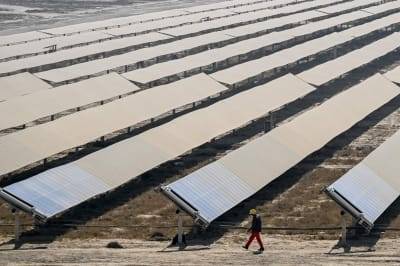Main Points In Hindi (मुख्य बातें – हिंदी में)
-
गुजरात का खावड़ा संयंत्र: भारत ने खावड़ा में दुनिया का सबसे बड़ा नवीकरणीय ऊर्जा संयंत्र स्थापित किया है, जिसमें लगभग 60 मिलियन सौर पैनल और 770 पवन टरबाइन शामिल हैं। यह संयंत्र 538 वर्ग किलोमीटर में फैला हुआ है और वर्तमान में 11 गीगावॉट बिजली का उत्पादन करता है, जो 2029 में 30 गीगावॉट तक बढ़ने की योजना है।
-
कार्बन तटस्थता और नवीकरणीय ऊर्जा लक्ष्य: भारत ने 2070 तक कार्बन तटस्थ होने का संकल्प लिया है और 2030 तक अपनी नवीकरणीय ऊर्जा क्षमता 200 से बढ़ाकर 500 गीगावॉट करने का लक्ष्य रखा है, जिसमें से 300 गीगावॉट अकेले सौर ऊर्जा से आने की उम्मीद है।
-
बिजली की बढ़ती मांग: भारत की जनसंख्या और आर्थिक विकास के कारण बिजली की मांग 2000 के बाद से दोगुनी हो गई है। यह बढ़ती मांग और बढ़ती शहरीकरण की आवश्यकता को पूरा करने के लिए सौर ऊर्जा और अन्य नवीकरणीय स्रोतों की बढ़ती भूमिका पर जोर दे रहा है।
-
अडानी समूह का निवेश और चुनौतियाँ: अदानी समूह ने नवीकरणीय ऊर्जा में 35 बिलियन अमेरिकी डॉलर का निवेश करने की योजना बनाई है, हालाँकि हाल में कुछ धोखाधड़ी के आरोपों ने समूह के भविष्य के निवेश संभावनाओं को प्रभावित किया है, जिसके बावजूद सौर ऊर्जा परियोजनाओं पर जोर दिए जाने की उम्मीद है।
- सौर ऊर्जा की लागत: सौर ऊर्जा की लागत कोयला आधारित ऊर्जा संयंत्रों के साथ प्रतिस्पर्धी बन गई है, जिससे इसके उपयोग में वृद्धि हो रही है। हालांकि, ऊर्जा की मांग को संतुलित रखने के लिए आवश्यक है कि सौर ऊर्जा के साथ-साथ अन्य ऊर्जा स्रोतों का समुचित प्रबंधन किया जाए।
Main Points In English(मुख्य बातें – अंग्रेज़ी में)
Here are the main points derived from the given article about India’s renewable energy initiative, specifically focusing on the Khavda solar plant:
-
Massive Renewable Energy Project: India is establishing the world’s largest renewable energy plant in Khavda, Gujarat, featuring approximately 60 million solar panels and 770 wind turbines spread across 538 square kilometers. This project symbolizes India’s commitment to expanding solar energy.
-
Significant Power Generation Goals: Currently, the Khavda plant can produce up to 11 gigawatts of electricity, with plans to increase this capacity to 30 gigawatts by 2029. This would make it the most powerful energy production site globally, surpassing China’s Three Gorges Dam.
-
Rising Energy Demand: India’s energy demand has doubled since 2000 due to demographic growth, economic development, and urbanization. To address this, India aims to increase its renewable energy capacity from 200 gigawatts to 500 gigawatts by 2030, with a significant portion expected to come from solar energy.
-
Financial Commitment and Challenges: The Adani Group, behind the Khavda project, has pledged $35 billion for renewable energy development by 2030. However, there are challenges due to recent allegations of fraud against the group’s founder, which could impact its ability to raise funds, even as the broader push for solar energy continues.
- Government Support and Market Dynamics: The Indian government is encouraging the adoption of solar energy through incentives, aiming to support 10 million households with solar panels. Despite these efforts, the country remains reliant on coal for a significant portion of its energy, highlighting the need to balance energy consumption with sustainable practices.


Complete News In Hindi(पूरी खबर – हिंदी में)
खावदा (भारत), 2 दिसंबर – सौर पैनलों की विशाल रेखाएं भारत के पश्चिमी रेगिस्तानों में चमकते सूरज को प्रतिबिंबित करती हैं, एक चमकदार महासागर जो केवल तेज हवा के टरबाइनों द्वारा टूटा हुआ है।
भारत, पाकिस्तान के साथ अपनी उजाड़ सीमा पर, दुनिया का सबसे बड़ा नवीकरणीय ऊर्जा संयंत्र बनाने का दावा कर रहा है, जो सौर ऊर्जा को बढ़ावा देने के लिए दृढ़ संकल्प का प्रतीक है।
गुजरात राज्य में खावड़ा संयंत्र में लगभग 60 मिलियन सौर पैनल और 770 पवन टरबाइन हैं जो 538 वर्ग किलोमीटर में फैले हुए हैं – लगभग विशाल मेगासिटी मुंबई के आकार के बराबर।
स्क्रीन की एक दीवार के सामने, मुट्ठी भर ऑपरेटर इस नारे के तहत मशीनों की निगरानी करते हैं: “अडानी समूह: अच्छाई के साथ विकास”।
“आज, हम 11 गीगावाट तक बिजली का उत्पादन कर सकते हैं,” अदानी ग्रीन एनर्जी के उपाध्यक्ष, मनिंदर सिंह पेंटल ने कहा, जो भारतीय समूह अदानी समूह की सहायक कंपनी है, और जिसमें फ्रांस की टोटलएनर्जीज़ की 20 प्रतिशत हिस्सेदारी है।
उन्होंने गर्व से कहा, “2029 में, हम 30 गीगावॉट तक उत्पादन करने में सक्षम होंगे।”
उस समय, भारत एक और रिकॉर्ड तोड़ देगा, जिसमें खावड़ा चीन के 18 गीगावॉट थ्री गॉर्जेस पनबिजली बांध को पछाड़कर दुनिया का सबसे शक्तिशाली बिजली उत्पादन स्थल बन जाएगा।
दुनिया के सबसे अधिक आबादी वाले देश में बिजली की अत्यधिक आवश्यकता है, जहां जनसांख्यिकीय विस्तार, आर्थिक विकास और तेजी से शहरीकरण के कारण 2000 के बाद से मांग दोगुनी हो गई है।
भारत ने 2070 तक कार्बन तटस्थ होने का संकल्प लिया है और उसी के हिस्से के रूप में, नई दिल्ली चाहता है कि उसकी नवीकरणीय ऊर्जा क्षमता 200 गीगावॉट से बढ़कर 2030 तक 500 गीगावॉट हो जाए – जो कि उसके वर्तमान ऊर्जा मिश्रण का आधा है। उसे उम्मीद है कि 300 गीगावॉट अकेले सौर ऊर्जा से आएगा .
अंतर्राष्ट्रीय ऊर्जा एजेंसी ने इस साल एक रिपोर्ट में कहा कि भारत को “2030 तक अपनी 2022 की नवीकरणीय क्षमता को लगभग तीन गुना करने की उम्मीद है”, जो सबसे बड़े नवीकरणीय ऊर्जा उत्पादकों के बीच अपना तीसरा स्थान बनाए रखेगा।
15 अक्टूबर, 2024 को ली गई यह हवाई तस्वीर भारत के गुजरात राज्य के खावड़ा में अदानी ग्रीन रिन्यूएबल एनर्जी प्लांट में स्थापित सौर पैनलों को दिखाती है। भारत, पाकिस्तान के साथ अपनी उजाड़ सीमा पर, दुनिया का सबसे बड़ा नवीकरणीय ऊर्जा संयंत्र बनाने का दावा कर रहा है, जो सौर ऊर्जा को बढ़ावा देने के लिए दृढ़ संकल्प का प्रतीक है। – एएफपी तस्वीर
अडानी बम धमाका
जैसा कि प्रधान मंत्री नरेंद्र मोदी “सौर क्रांति” की बात करते हैं, पूरे भारत में बिजली संयंत्रों से लेकर छतों तक पैनल लगाए जा रहे हैं।
लेकिन अदाणी ग्रीन एनर्जी के सीईओ सागर अदाणी ने कहा कि उत्पादन का पैमाना मायने रखता है क्योंकि छोटी इकाइयों की तुलना में बड़ी इकाइयों के साथ देश के बेसलोड को बढ़ाना आसान और तेज है।
उन्होंने कहा, ”देश को बड़ी मात्रा में बड़े संकेंद्रित बड़े स्थानों की जरूरत है।” “आपके पास 50 मेगावाट की 200 परियोजनाएं हो सकती हैं, उससे भारत को कुछ नहीं होने वाला है।”
अडानी ने 2030 तक नवीकरणीय ऊर्जा के लिए 35 बिलियन अमेरिकी डॉलर (RM155 बिलियन) देने की कसम खाई है।
हालाँकि, पिछले हफ्ते एक धमाकेदार अमेरिकी अभियोग ने जटिलताएँ पैदा कर दी हैं, जब टाइकून के संस्थापक गौतम अडानी और कई अधीनस्थों पर धोखाधड़ी का आरोप लगाया गया था – टोटलएनर्जीज़ ने समूह में सभी नए निवेशों को रोक दिया – आरोपों का जमकर खंडन किया गया।
लेकिन पर्यवेक्षकों का सुझाव है कि सौर ऊर्जा पर जोर जारी रहेगा।
एक बाज़ार विश्लेषक ने कहा, “इसका असर ईमानदार खिलाड़ियों पर नहीं पड़ेगा,” लेकिन चेतावनी दी कि इससे “अडानी की धन जुटाने की क्षमता प्रभावित होगी”।
अरबपति मुकेश अंबानी के रिलायंस समूह ने भी हरित ऊर्जा में 10 बिलियन अमेरिकी डॉलर का निवेश करने का वादा किया है, जिसमें आंध्र प्रदेश राज्य में 10GW सौर फार्म भी शामिल है।
गंभीर रूप से, सौर ऊर्जा की लागत कोयला आधारित संयंत्रों के लिए प्रतिस्पर्धी बनने के लिए कम हो गई है, जो भारत की 70 प्रतिशत बिजली का उत्पादन करते हैं।
इंटरनेशनल सोलर अलायंस (आईएसए) के निदेशक अजय माथुर ने कहा, ”यह एक अच्छी बात है।”
उन्होंने कहा कि हालांकि “प्रारंभिक निवेश दोगुना है”, सौर ऊर्जा के लिए प्रति किलोवाट घंटे बिजली की कीमतें अब कोयला संयंत्रों के बराबर या उससे कम हैं।
प्रमुख नवीकरणीय ऊर्जा उत्पादन दिग्गज भारत लाइट एंड पावर के तेजप्रीत चोपड़ा ने कहा कि परिवर्तन का हिस्सा बनना “अति रोमांचक” था, जबकि उन्होंने स्वीकार किया कि इसमें बड़ी बाधाएँ थीं।
उन्होंने कहा, “जब ऊर्जा की लागत कम हो गई है, तो वित्तीय रिटर्न अधिक कठिन हो गया है।” “आप पूंजी, निवेश और प्रौद्योगिकी को कैसे आकर्षित करते हैं?”
21 नवंबर, 2024 को ली गई यह तस्वीर सनसोर्स एनर्जी के कर्मचारियों को ग्रेटर नोएडा में भारतीय खाद्य सेवा कंपनी जुबिलेंट फूडवर्क्स के खाद्य प्रसंस्करण संयंत्र में स्थापित सौर पैनलों का निरीक्षण करते हुए दिखाती है। भारत ने 2070 तक कार्बन तटस्थ होने का संकल्प लिया है और उसी के हिस्से के रूप में, नई दिल्ली चाहता है कि उसकी नवीकरणीय ऊर्जा क्षमता 200 गीगावॉट से बढ़कर 2030 तक 500 गीगावॉट हो जाए – जो कि उसके वर्तमान ऊर्जा मिश्रण का आधा है। उसे उम्मीद है कि 300 गीगावॉट अकेले सौर ऊर्जा से आएगा . – एएफपी तस्वीर
बढ़ती बिजली की मांग
सरकारी वित्तीय प्रोत्साहन लोगों को स्विच करने के लिए प्रोत्साहित कर रहे हैं – जिसमें नई दिल्ली के उपनगरीय इलाके में एक कारखाना भी शामिल है।
जुबिलेंट फूड वर्क्स फैक्ट्री में 500 कर्मचारी कार्यरत हैं, जो अमेरिकी ब्रांडों के लिए पिज्जा और पेस्ट्री का उत्पादन करते हैं। इसकी 4,400 वर्ग मीटर की छत पर, लगभग 800 सौर पैनल इसकी 14 प्रतिशत बिजली ग्रिड की तुलना में बहुत सस्ती प्रदान करते हैं।
सनसोर्स एनर्जी के प्रवीण कुमाय ने कहा कि उनकी टीमों ने बुनियादी ढांचे की स्थापना और रखरखाव किया है।
कुमाय ने कहा, “प्रत्येक इकाई के लिए… हम उन्हें 4.3 रुपये (RM0.22) का बिल दे रहे हैं, जबकि ग्रिड लागत सात रुपये है।”
फ़ैक्टरी प्रबंधक अनिल चंदेल ने कहा कि यह एक “अच्छा सौदा” था, उनका लक्ष्य बिजली की 50 प्रतिशत ज़रूरतों की आपूर्ति तक विस्तार करना था।
21 नवंबर, 2024 को ली गई यह तस्वीर ग्रेटर नोएडा में भारतीय खाद्य सेवा कंपनी जुबिलेंट फूडवर्क्स के खाद्य प्रसंस्करण संयंत्र में सनसोर्स एनर्जी द्वारा स्थापित सौर पैनलों का एक हवाई दृश्य दिखाती है। – एएफपी तस्वीर
उन्होंने कहा, ”हमें इसे बनाए रखने में कोई परेशानी नहीं है।”
सरकार ने 10 मिलियन घरों के लिए पैनलों का समर्थन करने का भी वादा किया है।
लेकिन बिजली की मांग तेजी से बढ़ रही है और 2030 तक इसके 50 प्रतिशत तक बढ़ने की उम्मीद है।
मौजूदा कार्बन-भूखी प्रणाली प्रमुख बनी रहेगी।
तेजप्रीत चोपड़ा ने कहा, “हमें बिजली की जरूरत है और भारत के लिए इसका मतलब कोयला है।” “यही ग्रिड की वास्तविकता है।”
एनर्जी स्वराज फाउंडेशन के चेतन सोलंकी – जिसका अर्थ है “आत्म-संयम” – ने कहा कि सौर पैनल बिजली और रसायनों के मामले में उत्पादन की अपनी लागत के साथ आते हैं।
उन्होंने कहा, ”सौर ऊर्जा कोयले से बेहतर है, लेकिन आप इसका अंधाधुंध इस्तेमाल नहीं कर सकते।” उन्होंने कहा कि लोगों को बिजली की मांग पर भी लगाम लगानी होगी। “हमें ऊर्जा की खपत भी कम करनी होगी।” – एएफपी
Complete News In English(पूरी खबर – अंग्रेज़ी में)
Khavda, India – December 2 – Vast rows of solar panels glisten under the bright sun in the western deserts of India, resembling a shining ocean interrupted only by the turbines of strong winds.
India is claiming to build the world’s largest renewable energy plant along its barren border with Pakistan, symbolizing a strong commitment to solar energy.
The Khavda plant in Gujarat state features around 60 million solar panels and 770 wind turbines, covering an area of 538 square kilometers—equivalent to the size of the megacity Mumbai.
Before a large screen, a handful of operators oversee the machinery under the slogan: “Adani Group: Growth with Goodness.”
Maninder Singh Pental, the vice president of Adani Green Energy, a subsidiary of the Indian Adani Group, stated, “Today, we can produce up to 11 gigawatts of electricity.” The Adani Group holds a 20% stake from France’s TotalEnergies.
He proudly announced, “By 2029, we will be capable of producing 30 gigawatts.”
At that time, India will set another record, making Khavda the world’s most powerful electricity production site, surpassing China’s 18-gigawatt Three Gorges Dam.
There is a massive need for electricity in the world’s most populous country, where demographic growth, economic development, and rapid urbanization have doubled demand since 2000.
India has pledged to become carbon neutral by 2070. As part of this commitment, New Delhi aims to increase its renewable energy capacity from 200 gigawatts to 500 gigawatts by 2030, which would constitute half of its current energy mix. It anticipates that 300 gigawatts will come solely from solar energy.
The International Energy Agency reported this year that India is expected to “almost triple its renewable capacity by 2030,” maintaining its third position among the largest renewable energy producers in the world.
This aerial photograph taken on October 15, 2024, shows solar panels installed at the Adani Green Renewable Energy Plant in Khavda, Gujarat, India. India is claiming to build the world’s largest renewable energy plant, symbolizing a strong commitment to solar energy. – AFP photo
Adani’s Ambitious Plan
As Prime Minister Narendra Modi talks about a “solar revolution,” panels are being installed across India, from power plants to rooftops.
However, Adani Green Energy’s CEO, Sagar Adani, emphasized the importance of scale in production, stating that it’s easier and faster to increase the country’s base load with larger units compared to smaller ones.
He said, “The country needs large-scale concentrated locations.” “Having 200 projects at 50 megawatts each won’t help India.”
Adani has pledged to invest $35 billion in renewable energy by 2030.
However, a recent explosive indictment from the U.S. introduced complications as the founder Gautam Adani and several associates were accused of fraud—TotalEnergies has halted all new investments in the group, though these allegations have been vehemently denied.
But observers suggest that the focus on solar energy will continue.
A market analyst stated, “It won’t affect honest players,” but warned that it could “impact Adani’s ability to raise funds.”
Billionaire Mukesh Ambani’s Reliance Group has also pledged to invest $10 billion in green energy, which includes a 10GW solar farm in Andhra Pradesh.
Critically, the cost of solar energy has become competitive with coal-based plants, which produce 70% of India’s electricity.
Ajay Mathur, director of the International Solar Alliance (ISA), remarked, “That’s a good thing.” He noted that although “the initial investment is twice as much,” the costs for solar energy per kilowatt-hour are now equal to or less than that of coal plants.
Tejpreet Chopra from leading renewable energy producer India Ltd. stated that being part of this change is “very exciting,” even as he acknowledged the significant challenges involved.
He said, “As energy costs have decreased, financial returns have become more challenging. How do you attract capital, investment, and technology?”
This image taken on November 21, 2024, shows employees from SunSource Energy inspecting solar panels installed at the food processing plant of the Indian food service company Jubilant Foodworks in Greater Noida. India has pledged to become carbon neutral by 2070 and aims to increase its renewable energy capacity to 500 gigawatts by 2030. – AFP photo
Rising Electricity Demand
Government financial incentives are encouraging people to switch to solar energy—this includes a factory in the suburbs of New Delhi.
The Jubilant Foodworks factory employs 500 workers who produce pizzas and pastries for American brands. On its 4,400 square meter roof, around 800 solar panels provide electricity at 14% of the grid’s cost, making it significantly cheaper.
Praveen Kumai from SunSource Energy mentioned that their teams have set up and maintained the infrastructure.
Kumai stated, “For each unit… we are charging them 4.3 rupees, while the grid cost is seven rupees.”
Factory manager Anil Chandel remarked that this was a “great deal,” and they aim to expand to supply 50% of their electricity needs.
This photo taken on November 21, 2024, shows an aerial view of solar panels installed by SunSource Energy at Jubilant Foodworks’ food processing plant in Greater Noida. – AFP photo
He added, “We have no trouble maintaining it.”
The government has also promised to support solar panels for 10 million homes.
However, electricity demand is rapidly rising, with an expected increase of up to 50% by 2030.
The existing carbon-hungry system will likely remain dominant.
Tejpreet Chopra stated, “We need electricity, and for India, that means coal. That’s the reality of the grid.”
Chetan Solanki from the Energy Swaraj Foundation—meaning “self-restraint”—pointed out that solar panels also come with their own production costs in terms of energy and chemicals.
He said, “Solar energy is better than coal, but you cannot use it indiscriminately.” He emphasized that people need to curb electricity demand as well. “We also need to reduce energy consumption.” – AFP








